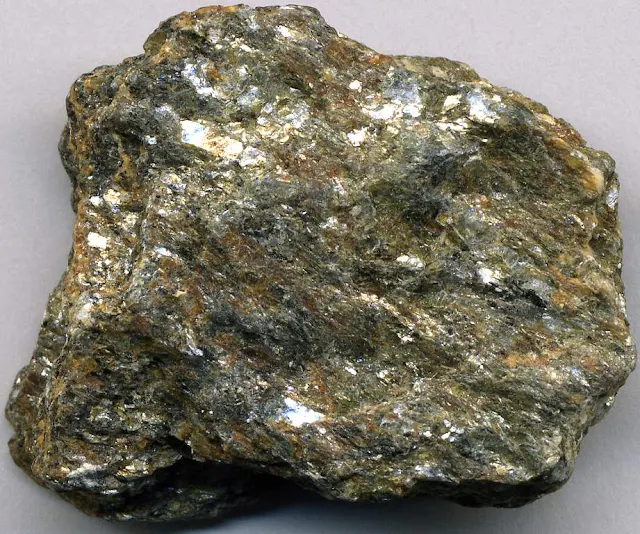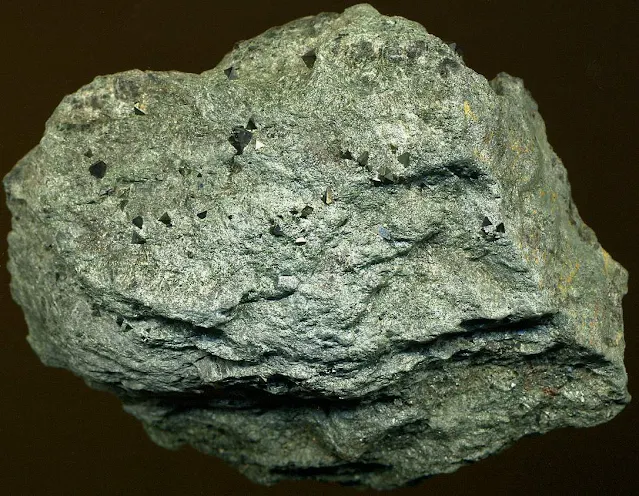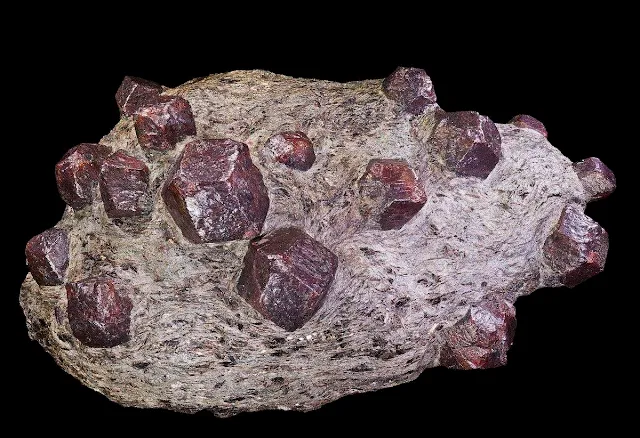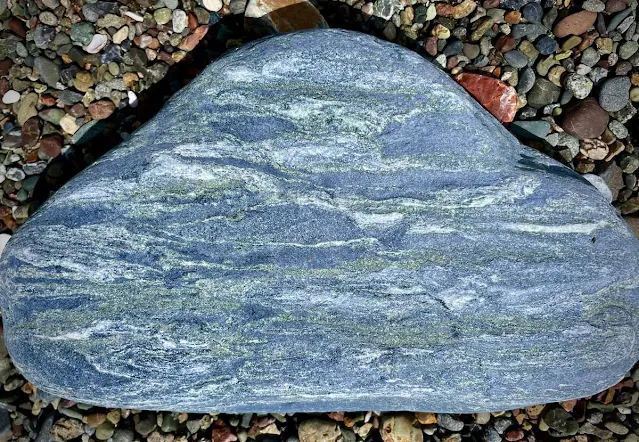Schist: Formation, Uses and Types of Schist
Schist is a type of metamorphic rock known for its distinctive layered or banded appearance. This characteristic, called foliation. This foliation is caused by the alignment of platy minerals, such as mica, chlorite, and talc, being flattened and aligned due to intense heat and pressure during metamorphism.
These layers are typically visible with the naked eye and give the rock a "schistose" appearance. These layers are usually visible to the naked eye and allow the rock to easily split into slabs.
The name "schist" is derived from the Greek word "schízein," which means "to split."
Schist's key features:
- Texture: Layered, easily split into thin flakes (foliated).
- Composition: Platy minerals like micas, chlorite, and talc, interleaved with granular minerals like feldspar and quartz. Color varies depending on minerals.
- Color: Green, gray, black, brown, even reddish hues.
- Hardness: Generally hard due to tight mineral packing.
Formation of Schist
Schist forms from the transformation of preexisting rocks. This formation occurs through regional metamorphism, a process associated with mountain building (orogenesis). During orogeny, large areas of rock are subjected to immense pressure and heat due to the collision of tectonic plates.
The formation of schist typically involves the following steps:
Parent Rock (Protolith): Schist usually forms from fine-grained sedimentary rocks like shale or mudstone. These rocks contain clay minerals, quartz, and other minerals that are subjected to metamorphism. Or Igneous rocks like volcanic tuffs.
Burial and Compression: As sedimentary rocks are buried deeper in the Earth's crust due to tectonic processes, they experience an increase in temperature and pressure. The increase in pressure and temperature triggers the metamorphic changes.
Recrystallization: The minerals within the parent rock undergo recrystallization, where the mineral grains rearrange themselves and grow larger. This process often results in the development of new minerals with preferred orientations, such as micas (biotite and muscovite), chlorite, and garnet.
Foliation: Schist is characterized by a foliated texture, meaning that the minerals within the rock are aligned in parallel planes or bands. This foliation is a result of the directional pressure during metamorphism. The alignment of platy minerals, such as micas, gives schist its distinctive schistosity.
Metamorphic Grade: The degree of metamorphism, or metamorphic grade, influences the final characteristics of schist. Higher grades of metamorphism typically lead to the development of coarser-grained schists with more pronounced mineral alignment.
Chemical Changes: Metamorphism can also involve chemical changes, such as the recrystallization of minerals into new mineral assemblages. This can lead to the formation of minerals like staurolite, kyanite, or garnet, depending on the specific conditions.
Schist formation is part of the broader field of metamorphic geology, and the specific conditions under which it forms can vary. The type of minerals present, the amount of pressure and temperature, and the duration of metamorphism all contribute to the unique characteristics of schist rocks.
 |
| Garnet-chlorite schist. |
Schist Mineral Composition
The mineral composition of schist varies depending on its original rock type and the specific metamorphic conditions it underwent.
The mineral composition of schist can vary, but some common minerals found in schist include:
Micas (Biotite and Muscovite): Micas are platy minerals that contribute significantly to the foliated texture of schist. Biotite and muscovite are common micas found in schist, and their alignment gives the rock its schistosity.
Quartz: Quartz is a common mineral in many rocks, including schist. It often occurs in schist as elongated grains that align with the foliation.
Feldspar: Feldspar is another common mineral found in schist. It can occur in various forms, including microcline and plagioclase, and its presence contributes to the overall mineral assemblage of the rock.
Garnet: In some schists, especially those with a higher metamorphic grade, garnet may be present. Garnet is a relatively hard mineral that forms under high-pressure conditions.
Chlorite: Chlorite is a green mineral that is often present in lower-grade schists. It forms during the metamorphism of minerals like biotite.
Staurolite and Kyanite: These minerals are indicative of higher metamorphic grades. Staurolite often forms distinctive cross-shaped crystals, while kyanite occurs in elongated bladed crystals.
Epidote: Epidote is a common accessory mineral in schist, forming elongated crystals that contribute to the overall mineralogy.
The specific minerals present in schist depend on factors such as the protolith (original rock), the degree of metamorphism, and the local geological conditions.
Properties of Schist
Schist is characterized by the following properties:
Foliation: The most defining feature of schist is its foliation. Imagine layers or bands of minerals running through the rock, often in alternating light and dark colors.
Hardness: Schist is generally a hard rock, thanks to the presence of minerals like quartz and feldspar.
Grain Size: Schist typically falls in the fine- to medium-grained category. This means you can see the individual mineral grains with the naked eye or a hand lens, ranging from 0.25 to 2 millimeters in size.
Color: The color palette of schist is diverse. The alternating bands of minerals often lead to a mix of light and dark hues, with silver, gray, green, and black being common. Some schists even exhibit a sparkly appearance due to the presence of mica minerals.
Cleavage: The foliated structure of schist also gives it a distinct cleavage property. It tends to break easily along the planes of mineral alignment, making it possible to split the rock into thin slabs.
Metamorphic Grade: Schist represents a medium-grade metamorphic rock. This means it experienced higher temperatures and pressures compared to slate, a lower-grade metamorphic rock with a similar foliation but finer grain size. With even higher temperatures and pressures, schist can further evolve into gneiss, a coarser-grained and less distinctly layered rock.
Other properties: Schist is generally poor conductors of heat and electricity. Its density can vary depending on the mineral composition but usually falls within the 2.6-2.8 g/cm³ range.
Types and Variety of Schist
Depending on the protolith and the intensity of metamorphism, different types of schist form, each with distinct characteristics and mineral compositions. Schist Types by Mineral Composition:
Mica Schist
 |
| The muscovite schist is a common variety of mica schist. |
Mica Schist Characterized by shiny flakes of mica, usually biotite or muscovite, giving the rock a sparkly appearance. Often appears in shades of silver, gray, and black.
- Composition: Primarily mica (50-80%), with quartz and feldspar also present.
- Formation: Metamorphism of sedimentary rocks rich in clay minerals.
- Uses: Decorative stonework, roofing slates, flagstones, and electrical insulators.
Types and Variety of Mica Schist
Biotite Schist
Biotite Schist, This common type features prominent flakes of biotite mica, giving it a sparkly, black or brown appearance.
Muscovite Schist
Muscovite Schist, Characterized by silvery-white muscovite mica flakes, muscovite schist often appears light-colored and has a softer feel.
Garnet Mica Schist
Garnet Mica Schist, Combining biotite or muscovite with embedded garnet crystals, this schist exhibits a speckled appearance with reddish-brown garnet grains.
Chlorite Schist
 |
| Chlorite schist from the Precambrian of Michigan, USA. Photo: James St. John |
Chlorite Schist Characterized by Greenish hue due to the presence of chlorite, often with a greasy feel. Can also be gray or black. Chlorite Schist Often dubbed "greenstone" due to its predominant chlorite mineral. It's typically fine-grained and possesses a strong foliation.
- Composition: Dominated by chlorite (50-80%), with quartz and feldspar present.
- Formation: Metamorphism of volcanic rocks or sedimentary rocks rich in iron and magnesium.
- Uses: Building stone, landscaping material, and source of talc.
Garnet Schist
 |
| Garnet schist, from Gaisberg Valley, Austria |
Garnet Schist is a type of schist contains garnet, a semi-precious gemstone that can be red, pink, or orange. Garnet schists are often found in high-grade metamorphic zones.
- Composition: Mica (biotite or muscovite), quartz, feldspar, and garnet (10-20%).
- Formation: High-pressure metamorphism of sedimentary or volcanic rocks rich in aluminum and iron.
- Uses: Decorative stonework, jewelry (garnet), and abrasives.
Hornblende Schist
 |
| Hornblende schist (Manhattan Island, New York State, USA) Photo: James St. John |
Hornblende Schist is a type of schist contains hornblende, a dark green or black amphibole mineral. Hornblende schists are often found in high-grade metamorphic zones.
- Composition: Primarily hornblende (50-80%), with quartz and feldspar present.
- Formation: Metamorphism of igneous or volcanic rocks rich in calcium and magnesium.
- Uses: Building stone, landscaping material, and source of hornblende for industrial applications.
Actinolite Schist: Similar to hornblende schist, but with actinolite, a less common amphibole mineral.
Graphite Schist
 |
| Graphite Schist |
Graphite Schist is a unique type of schist contains significant amounts of graphite, a form of carbon, the mineral responsible for its dark gray to black color and its ability to conduct electricity.
- Composition: Graphite (20-50%), with quartz, mica, and feldspar present.
- Formation: Metamorphism of sedimentary rocks rich in organic matter.
- Uses: Lubricants, electrical conductors, and source of graphite for industrial applications.
Blueschist
 |
| Blueschist from San Simeon, California Photo: Peter D. Tillman |
Blueschist is a rare type of schist forms under high pressure and low temperatures, often associated with deep-sea environments. Its characteristic blue-gray color comes from the mineral glaucophane.
Blueschist Applications: Primarily used for scientific study due to its unique formation conditions and potential information about past tectonic activity.
Kyanite Schist
 |
| Kyanite Schist. Photo: James St. John |
Kyanite Schist is a unique type of schist contains kyanite, a bladed blue mineral that creates a striking visual contrast with the other minerals. Its resistance to heat and wear makes it suitable for use in high-temperature applications like furnaces and kilns.
Where is Schist Found
Schist can be found in various locations around the world.
Geographical Distribution:
Mountain ranges: Schist commonly forms during mountain building processes (orogeny) and is often exposed in the exposed cores of mountain ranges. Examples include the Himalayas, Alps, Appalachians, and Rockies.
Plate boundaries: Convergent plate boundaries, where tectonic plates collide, are prime locations for schist formation due to the intense heat and pressure generated during collisions. Examples include the California Coast Range and the Scottish Highlands.
Specific Locations:
Manhattan schist is primarily found in New York City and its surrounding areas. It forms the bedrock of much of the borough of Manhattan, as well as parts of the Bronx, Queens, and Brooklyn. Manhattan schist is primarily found in New York City and its surrounding areas, specifically in southeastern New York state. Manhattan schist is the second oldest bedrock in the city, formed around 450 million.
Black Canyon of the Gunnison National Park (USA): Exposed spires and cliffs showcase the beauty of schist formations.
Sweetwater Creek Park near Atlanta (USA): Garnet schist formations offer a glimpse into the metamorphic process.
Piedmont region of the Eastern US: Mica schists are common throughout this region.
Scotland: A variety of schist formations are found across the country, including the famous Highland Schist Plateau.
Himalayan region: Schists are prominent in the mountainous regions of India, Nepal, and Bhutan.
Uses of Schist
Schist, a beautiful and versatile metamorphic rock, boasts a surprising variety of uses!
Construction
- Foundations, walls: Durable and readily available, it's been used historically for building.
- Paving, flagstones: Easy to cut flat, it makes attractive and hard-wearing walkways.
- Facing stones, veneers: Its beauty and patterns add a decorative touch to buildings.
Landscaping and Decoration
- Rock gardens, water features: Its layered look enhances natural settings.
- Sculpting: Some types are soft enough for carving.
Other Uses
- Mineral extraction: Schist often contains valuable minerals like graphite and mica.
- Electrical insulation: Certain types have excellent insulating properties.
Schist FAQs
What is the hardness of schist?
Most schists fall within the range of 4 to 6 on the Mohs scale of mineral hardness.
- Schists with high quartz content:These tend to be harder, closer to 5-6 on the Mohs scale.
- Mica-rich schists: These are slightly softer, closer to 4-5 on the Mohs scale.
- Talc schists: These are the softest variety, falling around 1-2 on the Mohs scale.
What is the difference between schist and gneiss?
Schist vs. Gneiss
Texture: Schist is fine-grained and flaky, while gneiss is coarser-grained and banded.
Formation: Schist forms from medium-grade metamorphism of mudstone / shale, while gneiss forms from higher-grade metamorphism of various rock types.
Composition: Schist is mainly mica minerals, while gneiss has a wider variety of minerals like quartz, feldspar, and mica.
Read also:
Contact Metamorphism Vs. Regional Metamorphism
The Differences Between Metamorphic Rocks and Igneous Rocks
Gemstones Found in Metamorphic Rocks









%20(1).webp)